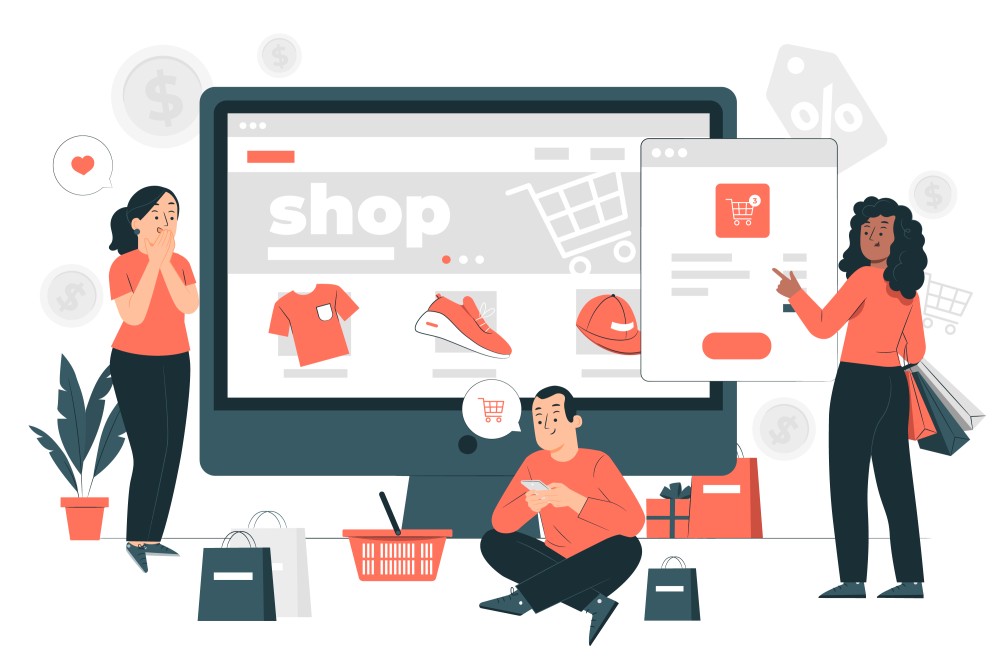E-commerce doesn’t need any introduction now. It’s a familiar one in the market. No wonder in a few years Ecommerce can become a crucial part of everyone’s life. Want to be part of Ecommerce? Do you know anything about eCommerce? If not, this article is here for you. Here’s what you need to know about e-commerce.
Table of Contents
What Is an E-commerce?
E-commerce is a process of selling and buying services online. It comprises systems, data, and tools.
One of the popular eCommerce platforms is Shopify. Shopify was launched in 2004. By 2019, Shopify had 1,000,000 active users. Hire a Shopify agency to build an excellent Shopify Website. Here add the types of e-commerce:
- Business-to-business (B2B): This type of e-commerce resembles the exchange of services, products, or information electronically. It happens within businesses rather than businesses to customers.
- Business-to-consumer (B2C): This e-commerce type is the retail basis of e-commerce. This is the place where businesses sell services and data. For example, Amazon is the best B2C e-commerce type that’s dominating its market.
- Consumer-to-business (C2B). This is another kind of e-commerce where customers sell their services & products online. So, brands can bid on and buy them. Popular C2B platform includes selling royalty-free images, photographs, design elements, and media like iStock.
- Consumer-to-consumer (C2C). This is another type of e-commerce where customers trade data, services, and products with one another online. These are conducted by using a third party that offers an online platform where transactions are carried out.
- Consumer-to-administration (C2A): This type resembles the transactions performed online between consumers & governments or public admin. The government purchases services through individuals. Whereas, individuals use electronics frequently for social security, health care systems, and taxes.
- Business-to-administration (B2A). Here the transactions are conducted online within government or public administration & companies. These services or products refer to fiscal days, registers, legal documents, employment, etc. And companies carry out these electronically.
- Mobile e-commerce: Popularly known as m-commerce. It conducted online sales transactions through mobile devices. This e-commerce type involves payments, banking, and mobile shopping.
History of Ecommerce
Thanks to mobiles and technology now we can shop with just a click. Every one of us has shopped online and taken part in e-commerce. E-commerce is everywhere and it’s pretty famous. Still, only a few know its back story and history.
In the 1960s, when the internet wasn’t a thing, companies utilized an electronic system known as Electronic Data Interchange. It facilitates document transfer. But, in 1994 the first transaction happened.
Since then the industry took different routes that resulted in great evolution. Conventional brick-and-mortar stores started to embrace new technology to keep going with companies such as Amazon. These businesses offer a virtual space for products & services that are accessible to consumers. Experts such as the Shopify plus agency made it simple for people to build online e-commerce stores. So, anyone could interact with the companies via smartphones or by installing apps to buy.
What Is an E-commerce Website?
An e-commerce website is a website that services or goods. This website adheres to several e-commerce business models. Here are the types of eCommerce websites which you find online:
- Physical Goods Website: Brick & mortar stores host stores to sell to a wide audience. It’s great to boost sales yet not the physical Service-based site.
- Digital Products Website: Businesses sell digital products such as games, and software. It doesn’t require physical stores to sell products.
- Dropshipping Website: Dropshipping is where retailers sell goods to consumers on the online store without inventory.
What are the pros and cons of e-commerce?
Pros:
- Cost-effective prices: For physical stores, you should invest in utilities, rent, and more. Whereas, operating e-commerce doesn’t need you to pay for anything other than certain ecommerce platform prices.
- Available 24/7: In contrast to the physical store, eCommerce isn’t available 24/7. Your website could accept orders if consumers want to buy which drives more sales.
- No limit: E-commerce platforms have no limits regarding business that you can’t find in the brick-and-mortar. You can remove or add products to the website easily.
- Reach more people: Although your business is in an international market you can sell nationally. No matter how small a city or town you live in, you can sell to many markets.
- Track shipments and sales: Shopify makes it simple for you to track shipments and sales. Gather this data to use these insights for targeting potential markets.
- Virus-free shopping: Unlike physical stores, online stores can stay open anytime After the COVID-19 outbreak, Ecommerce pros outweigh its cons.
Cons:
- It’s not everyone’s cup of tea: Although people love shopping online few tend to shop physically. Few people like to touch and feel products.
- Fraud: Data and credit card fraud are rampant. The biggest risk of e-commerce is – Fraud. Identity and credit card, money theft are common here that’s affecting several costumes.
- Cart abandonment: E-commerce is quite easy for customers to window shop. People with no or less intention of buying impact your sales.
- Comparison: With online shopping, customers could compare products to search for a lower price. This makes merchants lessen their profit margin.
Internet: Customers need Internet access to buy from retailers. As eCommerce platforms functionalities need high-speed Internet access to get an optimal customer experience.
Writers Column brings you informative and engaging articles and blogs in various niches. Keep Reading





